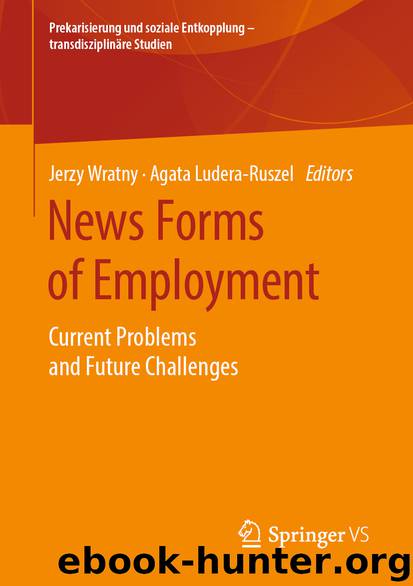News Forms of Employment by Unknown

Author:Unknown
Language: eng
Format: epub
ISBN: 9783658285111
Publisher: Springer Fachmedien Wiesbaden
2 Digital Labour Platforms—Taxonomy and Scope of the Analysis
Platform-mediated work is a broad term chiefly encompassing two categories of work: on-demand work and crowdwork. The discourse of labour law scholars investigating the gig-economy has been mainly framed around the question of whether platforms like Uber or Deliveroo should be classified as direct employers of on-demand workers. Alternatively, some scholars have applied the TWA framework to analyse work-on-demand (Faioli 2018) and crowdworking platforms (Ratti 2017). However, most academics rightly agree that the categorisation of on-demand platforms as TWAs is hardly feasible (Askitas et al. 2018). In what follows, I outline the main limitations of this approach.
Firstly, in the case of work-on-demand platforms, a client is typically a private individual using the platform to gain immediate access to a single service rather than a business undertaking which employs permanent workers and avails itself of platform workers to cover intermittent job vacancies. Thus, the digital workforce does not form part of the enterprise of the user undertaking. Rather, in organizational terms, on-demand workers are integrated into the platform-based company.
Secondly, it is widely acknowledged that many on-demand platforms exercise strong discretionary power and tight control over their workforce. The platforms providing transportation and food-delivery services are illustrative of how digital channels can be used not only to match workforce with clients but also to manage work, inter alia by providing incentives to take up the assignments at a particular time and location (e.g. Ivanova et al. 2018). They unilaterally set the working conditions, including payment rates, and direct the entire work process. Therefore, these work arrangements do not correspond to the concept of TAW, which requires that the direction and supervision of work rest on the third party- the user undertaking for which the services are provided.
Thirdly, Uber-like platforms should be considered as a seller of services in the sector in which they operate, rather than a software provider facilitating the intermediation between independent businesses. As famously expressed in the O’Connor v Uber Technologies judgment, ‘Uber does not simply sell software; it sells rides.’2 Similarly, the Court of Justice of the European Union (CJEU) has recognised that Uber provides services in the field of transport rather than ‘information society services.’3
In light of the above, the paper does not consider on-demand platforms as intermediaries in the sense of TWA. Unlike the triangular work relationship, both the direction (supervision) and the functions of a de facto employer (risk, the obligation of payment), should be assigned one actor, i.e. the platform. Indeed, a number of recent litigations regarding some of the leading on-demand platform like Uber,4 Deliveroo5 and Foodora6 have recognised them as factual and legal employers of drivers (riders).
As regards ‘crowdworking platforms’, this term is often used as an umbrella term encompassing all types of web-based digital labour platforms. It refers jointly to microtask platforms7 (e.g. Amazon Mechanical Turk); content-based creative crowdwork platforms (TopCoder)8; and freelance marketplaces such as Upwork (Berg et al. 2018). The platforms included in the first two categories assume different functions from
Download
This site does not store any files on its server. We only index and link to content provided by other sites. Please contact the content providers to delete copyright contents if any and email us, we'll remove relevant links or contents immediately.
Adulting by Kelly Williams Brown(4486)
Drawing Cutting Edge Anatomy by Christopher Hart(3453)
Figure Drawing for Artists by Steve Huston(3380)
Draw Your Day by Samantha Dion Baker(3286)
Drawing Shortcuts: Developing Quick Drawing Skills Using Today's Technology by Leggitt Jim(2996)
Make Comics Like the Pros by Greg Pak(2852)
Rapid Viz: A New Method for the Rapid Visualization of Ideas by Kurt Hanks & Larry Belliston(2833)
0041152001443424520 .pdf by Unknown(2783)
How Proust Can Change Your Life by Alain De Botton(2742)
Draw to Win: A Crash Course on How to Lead, Sell, and Innovate With Your Visual Mind by Dan Roam(2732)
How The Mind Works by Steven Pinker(2729)
Day by Elie Wiesel(2717)
Draw-A-Saurus by James Silvani(2653)
Tattoo Art by Doralba Picerno(2599)
Modern Cartooning by Christopher Hart(2557)
Learn Drawing Quickly by Sharon Finmark(2520)
Poses for Artists Volume 2 - Standing Poses: An essential reference for figure drawing and the human form. (Inspiring Art and Artists) by Justin Martin(2517)
Drawing and Painting Birds by Tim Wootton(2438)
Poses for Artists - Dynamic & Sitting: An essential reference for figure drawing and the human form (Inspiring Art and Artists Book 1) by Justin R Martin(2433)
